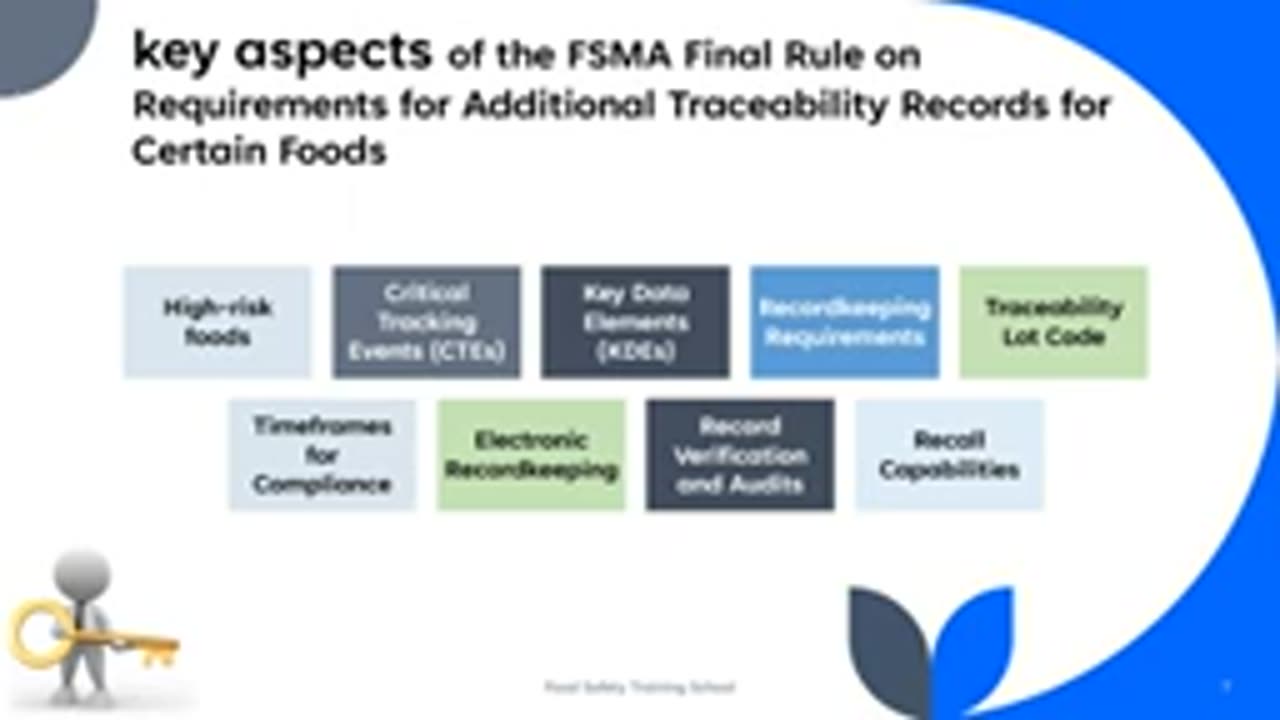Premium Only Content

Traceability in the Food Supply Chain │ Food Safety
### **Traceability in the Food Supply Chain**
**Traceability** refers to the ability to track and trace the movement of food products throughout the supply chain, from their origin to their final destination. It plays a crucial role in ensuring food safety, quality, and transparency, as well as protecting consumers from foodborne illnesses, contamination, and fraud. Traceability allows businesses, regulators, and consumers to identify the source of potential food safety issues quickly and efficiently.
In the context of food safety, traceability systems help to identify the origin of raw materials, monitor the conditions under which food is processed, stored, and transported, and ensure that the food meets all relevant safety and quality standards.
---
### **Why Traceability Matters in the Food Supply Chain**
1. **Food Safety:**
- Traceability allows businesses to quickly identify the source of contamination if an issue arises. For example, in the case of a foodborne illness outbreak, being able to trace the contaminated food product back to its source can help prevent further spread and protect public health.
2. **Recall Management:**
- In the event of a food recall, traceability systems make it easier to track which products need to be removed from the market and identify affected consumers. This minimizes the scope and impact of the recall, protecting both consumers and the brand’s reputation.
3. **Compliance with Regulations:**
- Many countries have regulations requiring food traceability to ensure food safety and quality. For example, the **FSMA (Food Safety Modernization Act)** in the U.S. mandates that food businesses implement traceability systems for certain high-risk foods. Similarly, the European Union’s **Food Information Regulation** requires traceability in the food supply chain.
4. **Transparency and Consumer Trust:**
- Traceability systems enable businesses to provide transparency to consumers about the origins and safety of their food. This is particularly important in today’s market where consumers are increasingly concerned about the ethical sourcing, sustainability, and safety of the food they purchase.
5. **Preventing Food Fraud:**
- Traceability helps combat food fraud by ensuring that the food products sold are authentic and comply with labeling and sourcing claims. It reduces the likelihood of counterfeiting, mislabeling, and substitution.
6. **Improved Operational Efficiency:**
- Traceability systems can streamline operations by allowing food businesses to track inventory, monitor product movements, and manage supply chains more efficiently, helping to reduce waste and improve responsiveness to supply chain disruptions.
---
### **Key Components of Food Traceability**
1. **Identification and Labeling:**
- Clear and accurate labeling is the foundation of traceability. Every product, batch, and shipment should have unique identifiers (such as lot numbers, batch codes, or barcodes) that allow it to be tracked as it moves through the supply chain.
2. **Data Collection:**
- Accurate data must be collected at each step of the supply chain, including:
- **Production:** Information about the origin of raw materials, processing methods, and conditions.
- **Processing:** Data about how food was handled, packaged, and stored.
- **Distribution:** Tracking shipments, transportation conditions, and storage requirements.
- **Retail:** Information on product handling, shelf life, and consumer sales.
3. **Information Systems:**
- Technology platforms (such as software and databases) are used to store and manage traceability data. These systems allow stakeholders to access real-time information about the movement of food products through the supply chain.
4. **Communication Across the Supply Chain:**
- Traceability requires collaboration among all parties in the supply chain, including farmers, suppliers, processors, distributors, retailers, and regulators. Each must communicate product information and any issues effectively.
5. **Auditing and Verification:**
- Traceability systems should be regularly audited to verify that data is accurate, complete, and accessible. This ensures that the system remains reliable in the event of a safety concern or recall.
---
### **How Traceability Works in the Food Supply Chain**
1. **From Farm to Fork:**
- **Primary Producers (Farmers, Fishermen, etc.):** Traceability begins with the source of raw materials. For example, a farmer may record the use of pesticides, crop variety, harvest date, and other relevant information.
- **Processors:** The raw ingredients are transformed into finished products. At this stage, processors record information about the production, processing, and packaging of the food. Traceability ensures that the origin of all ingredients can be traced back to their source.
- **Distributors and Transporters:** As food moves through the supply chain, distributors and transporters are responsible for maintaining traceability records, including storage conditions and transport routes.
- **Retailers:** Food retailers also have a role in maintaining traceability by managing product stock and ensuring that products are labeled accurately and traceable back to their source.
- **Consumers:** At the point of sale, consumers can access traceability information through labeling, QR codes, or other methods to verify the food's origin.
2. **Batch and Lot Tracking:**
- Food products are typically grouped into **batches** or **lots**, which are assigned unique identifiers. This allows a specific group of products to be traced through the entire supply chain. In the event of a contamination issue, businesses can trace the affected batch or lot and take appropriate action (such as issuing a recall).
3. **Technology and Innovation:**
- **Barcodes and QR Codes:** These codes provide a digital link to traceability information. Consumers can scan the code to learn more about the product’s origin, ingredients, and processing.
- **Blockchain:** Some companies are exploring blockchain technology to enhance traceability. Blockchain allows for secure, transparent, and immutable tracking of food products from farm to fork, reducing the potential for fraud and improving trust.
- **RFID (Radio Frequency Identification):** RFID tags can be used to track food products throughout the supply chain in real-time, providing more efficient and accurate traceability.
---
### **Benefits of Traceability in the Food Supply Chain**
- **Faster Recall Responses:** In the event of a food safety issue, traceability enables quicker identification of affected products, reducing the time it takes to remove them from shelves and protect public health.
- **Enhanced Food Safety:** Traceability allows businesses to monitor the safety of food products and respond quickly to potential hazards, preventing contamination from spreading.
- **Regulatory Compliance:** Traceability helps companies comply with food safety regulations and standards, ensuring that they meet the necessary requirements set by government agencies and industry bodies.
- **Improved Customer Confidence:** Transparent traceability systems help build consumer trust by assuring them that products are safe, ethically sourced, and meet quality standards.
- **Supply Chain Efficiency:** Real-time traceability data enables businesses to optimize supply chains, improve inventory management, and reduce product waste.
---
### **Challenges of Food Traceability**
1. **Cost of Implementation:**
- Setting up and maintaining traceability systems can be costly, especially for smaller businesses that may struggle with the investment in technology and resources.
2. **Data Management:**
- Managing large amounts of traceability data can be complex, and ensuring that data is accurate, consistent, and up to date is a significant challenge.
3. **Interoperability:**
- Different organizations in the supply chain may use different systems and technologies, which can make it difficult to ensure seamless communication and data sharing between stakeholders.
4. **Global Supply Chains:**
- In international food supply chains, managing traceability across different regulatory environments and standards can be complex and require additional resources and coordination.
---
### **Conclusion**
Traceability is a critical component of food safety, quality control, and consumer protection. It enables businesses to track food products throughout the entire supply chain, helping to prevent contamination, manage recalls, ensure compliance with regulations, and build consumer trust. As consumer expectations for transparency continue to rise, effective traceability systems will play an increasingly important role in the global food industry.
-
 22:45
22:45
Brewzle
13 hours agoI Went Drinking In A Real Bourbon Castle
25.9K3 -
 48:36
48:36
PMG
1 day ago $1.87 earned"Parkland Parent Speaks Out On Kamala Harris Using Victims"
19.2K3 -
 4:06
4:06
The Lou Holtz Show
12 hours agoCoach Lou Holtz’s Heartfelt Christmas Message 🎄 | Family, Faith & Notre Dame Spirit 💚 #christmas
14.5K -
![ROSEANNE BARR - Her Journey, TRUMP, and the MAGA GOLDEN AGE! [INTERVIEW]](https://1a-1791.com/video/s8/1/M/m/B/2/MmB2v.0kob.1-small-ROSEANNE-BARR-Her-Journey-T.jpg) 51:35
51:35
Dr Steve Turley
1 day ago $17.95 earnedROSEANNE BARR - Her Journey, TRUMP, and the MAGA GOLDEN AGE! [INTERVIEW]
49.9K50 -
 57:38
57:38
The Tom Renz Show
10 hours agoMerry Christmas - The Tom Renz Show Christmas
87.8K16 -
 2:59:10
2:59:10
Wendy Bell Radio
21 hours agoThe Bridge Too Far
166K301 -
 1:03:45
1:03:45
Donald Trump Jr.
1 day agoHappy Festivus: Airing Our Grievances and Stopping The Swamp w/Sean Davis | TRIGGERED Ep.201
426K546 -
 1:30:30
1:30:30
Game On!
1 day ago $7.95 earnedTop 5 things you need to know for Sports Christmas!
74.3K5 -
 1:58:10
1:58:10
Robert Gouveia
1 day agoMatt Gaetz REJECTS Report, Sues Committee; Luigi Fan Club Arrives; Biden Commutes; Festivus Waste
297K234 -
 1:31:40
1:31:40
Adam Does Movies
1 day ago $16.33 earnedThe Best & Worst Christmas Movies! - LIVE!
117K8